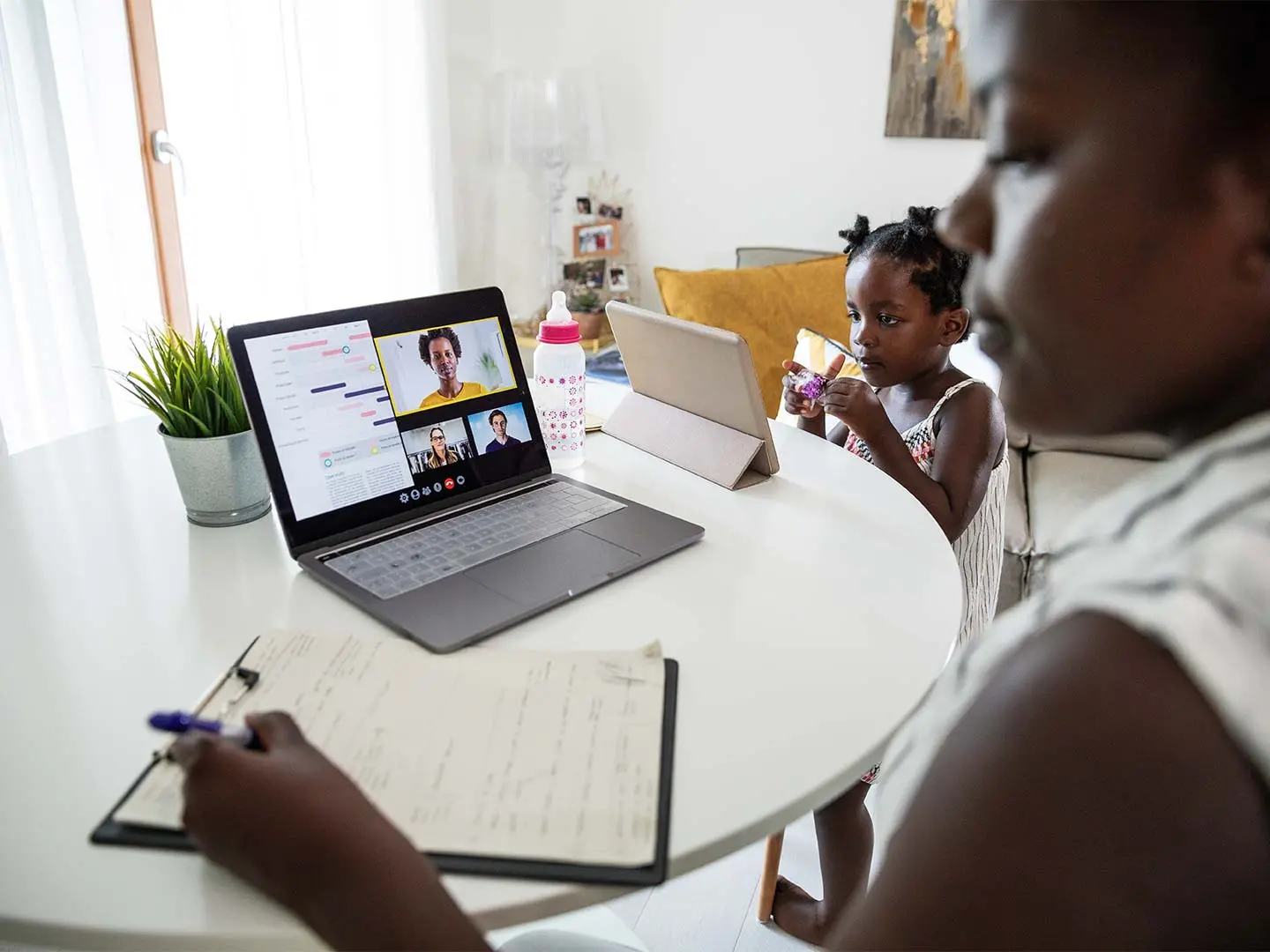Many of us have adjusted our working habits, rituals, and cultures to adapt to the tumultuous, mostly remote nature of the COVID-19 quarantine. Remote work isn’t a new concept, but most organizations haven’t had to operate with such a large portion of their workforce offsite until now.
Various parts of the United States are transitioning back to the office (or back home, again). So we wanted to review and share some of the important lessons we’ve learned, so we can all work better as a result of this shared experience.
The New Normal: Remote by Default
When everyone is remote, remote generally runs smoothly. When people are co-located, that usually runs smoothly. Each working environment has a different set of norms that enable it to work efficiently. For example, side conversations may be acceptable in a crowded meeting room, but in an online video conference, two people talking at the same time causes the whole meeting to become unintelligible. Ad-hoc, serendipitous conversations can be beneficial in co-located environments, but communication has to be intentional in a remote setting.
Where teams get into trouble is when these norms clash. Some people sitting in a conference room may have sidebar conversations that online participants are not aware of, thus excluding them from even the option of participating. Hallway conversations may drive important decisions for those who are in an office, but this excludes the input of remote-located individuals. Relationships forged over the (regularly sanitized) coffee machine build trust and shared knowledge that remote counterparts do not benefit from without intentionality.
Being aware of these difficulties and dynamics will only help us as we make decisions about what normal looks like and the culture our organizations want to craft. One of the best approaches to overcome the challenges of mixed environments is to adopt a “remote by default” culture. This means:
- All meetings have a call-in line (and, ideally, a video conferencing option).
- Meeting rooms are only reserved and utilized if all members are co-located. If a single person is remote, the meeting is now remote, and everyone calls in.
- Note-taking, whiteboarding and other exercises should be done digitally.
- Encourage “video on by default” to help increase personal connections. You can still allow exceptions for people with high-latency connections, other engagements, etc.
- Be more proactive in asking for input from each person individually. It’s harder to read body language via video chat, so you may not know how engaged everyone is.
Taking this approach evens the playing field for everyone. It doesn’t degrade the quality of the meeting; it just normalizes the dynamics.
Another way to equalize opportunities between remote and co-located workers is to schedule “pseudo-serendipitous” meetups. Having two workers randomly get coffee together and schedule 10-15 minutes to chat is a great way to build relationships and trust on a team or across the entire organization. Participants can use these times to chat about anything, work or personal. The goal is to create space for ideas to propagate between individuals in an unplanned way. This happens more naturally in a co-located setting, but it needs to be more deliberate in a remote context.
Here at Vervint, for example, employees can opt in to an automated service within Slack, called Donut. Every two weeks, it randomly assigns all participants into groups of 2-3 people who can have a conversation over Slack, chat on a video call or meet however each group prefers.
We All Need Increased Trust
For some of us, having remote colleagues is uncomfortable. There’s no great mechanism for knowing if they are working, cruising social media, or just checking email on their phone while they’re at the beach!
Having remote team members forces us to trust our co-workers to get their work done. We no longer have the (frequently false) visual indicators of “productivity,” such as seeing someone at their desk. Instead, our productivity needs to be measured by our output. And that’s not a bad thing! We build trust by making commitments to each other and delivering on those commitments. Every time you say you will do something and follow through, it increases trust.
If one of my co-workers tells me they’ll deliver a proposal by a certain time, and it comes through, I have more confidence and trust in them. If I later find out they spent the afternoon at the beach, more power to them! Maybe they have extra capacity, or maybe they worked in the evening. Regardless, the work was accomplished and we know that we can rely on each other.
And if we become co-located again, these bonds of trust will remain. If anything, our co-located work structures will benefit from them. We won’t have to feel like we have to give the appearance of being productive and can focus our energy on actually producing.
Everyone Needs More Flexibility — and Empathy
Flexibility has become essential with so much of the workforce remote. We’ve all become proficient in a wide variety of tools (Zoom, Teams, Slack, etc.) to communicate and collaborate. We’ve all gotten adept at pivoting from a snowballing email conversation to a video call. And we’ve become increasingly comfortable with asynchronous communication.
This increased need for flexibility is a reality of remote work. But it’s also symptomatic of the deeply personal effects this pandemic has had on everyone we work with. Being a parent (or working with a parent) when childcare is not available has created unique challenges. Similarly, parents are now being expected to educate their kids in virtual or hybrid settings as schools struggle to reopen. Individuals may be caring for elderly or at-risk family members. Some may be at higher risk for infection or long-term damage from COVID-19. Life, in general, has just become more complicated and stressful.
As a result, you can’t necessarily count on people being available during the typical eight-to-five workday. Online chats may have to switch to slower email conversations as a parent needs to be present with their children in the afternoon and resumes work in the evening. Suddenly, we feel a need to be “on” at all hours to keep projects moving forward.
But trust and flexibility are still at play in both directions. We trust that we can reach out if we see red flags or our work is delayed waiting on something important from a colleague. And I think we’re all happy to keep work moving forward if we can quickly shoot off an email or provide an answer, even if we’re with our family while doing so.
“Work Hours” Are Evolving
With more flexibility and steady (or even increased) productivity arising from remote work, colleagues and companies will undoubtedly become more flexible around work hours and working from home. If someone doesn’t have a meeting until the afternoon, why should they need to be at their desk by 8:00 AM?
Knowing a person’s availability during that time, however, is valuable. To balance collaboration and flexibility, some remote-friendly teams have adopted “core hours” where the entire team commits to being available for a set period every day. This helps to create collaboration-specific times during the day without giving up the ability to have a dynamic schedule. Night owls can get the bulk of their work done in the evening and run errands during the day. Early birds can crush their individual task lists and close the lid on their laptops in the early afternoon. As long as everyone knows the schedule and is available for collaboration during core hours, work keeps moving efficiently.
If, as a team, you don’t have “core hours,” it is vital to communicate the times you can be reached. Although work is changing, your teammates still rely on you and need to engage with you. Similarly, you need to know when you can engage with them. One way to add insight into everyone’s availability is to keep shared calendars updated with time away (or time-present). You could also build a shared team spreadsheet where each member documents their expected availability. Regardless of the method, communicating routines is important for collaboration and productivity.
Can We Please Eliminate Nonessential Meetings?
With our work and personal lives blurring, the cost of attending a meeting has increased. We are not just prioritizing our meetings against each other. Now, we also have to prioritize childcare, schooling, reduced grocery store hours, and all sorts of other personal engagements against our work meetings. The end result is that we increasingly value efficient, necessary meetings.
Now that we are months into this pandemic, I rarely attend meetings where chit-chat continues beyond the final invitee joining the call. Meetings have specific objectives, and once they are met, it’s time to leave. Occasionally, someone will ask a couple participants to stay on a call after it is finished, but that is nearly always intentional. We have come to value and respect the balance between people’s personal lives and work lives, and we don’t want to needlessly steal our teammates’ time. If you can get your work done sooner, that’s more time you get to spend with your family, friends, or hobbies.
Since we don’t feel obligated to stay at the office until the “end of the day,” pointless or aimless meetings are now seen for what they are: drains on our time.
Holding meetings without clear objectives or “just because we always have” has become borderline criminal. It’s important to keep meetings on-topic and moving along. We demonstrate respect by respecting each other’s time. When we’re all in an office together and a meeting runs long, we think we’re just bumping other work down the schedule. We now recognize that if my 11:00 meeting runs long, my co-worker’s children may be getting their lunch late. It’s more important now than ever to respect each other’s time.
In truth, even when we were holding meetings in person, running long ate into someone else’s collaboration time or individual work productivity. It was still disrespectful, but it felt slightly more okay because it was all “at work.” We’ve learned to be more efficient with our time and get our work done when we can. That doesn’t give us the liberty to abandon efficiencies in our meeting culture.
The Modern Workplace Will Continue to Change
Maintaining effective communication was one of the largest concerns as we all said goodbye and closed office doors at the outset of this global pandemic. Since then, we’ve proven that we can quickly adapt our communication styles, mediums, and techniques as needs arise. We’ve shown that we can be compassionate to our coworkers who are balancing their intermixed work and life. And we’ve learned to accept grace from others when we need it ourselves.
It’s important that we don’t lose sight of these lessons as we return (or don’t return) to our respective offices. Don’t let familiar habits and routines undermine the growth we’ve experienced. If nothing else, this pandemic has taught us to acknowledge and perhaps even share how human we all are.
Oh, and that boardshorts are now appropriate workplace attire.


